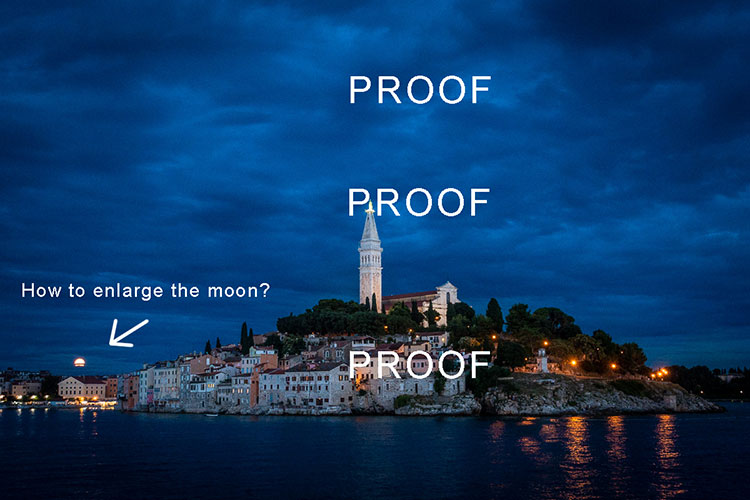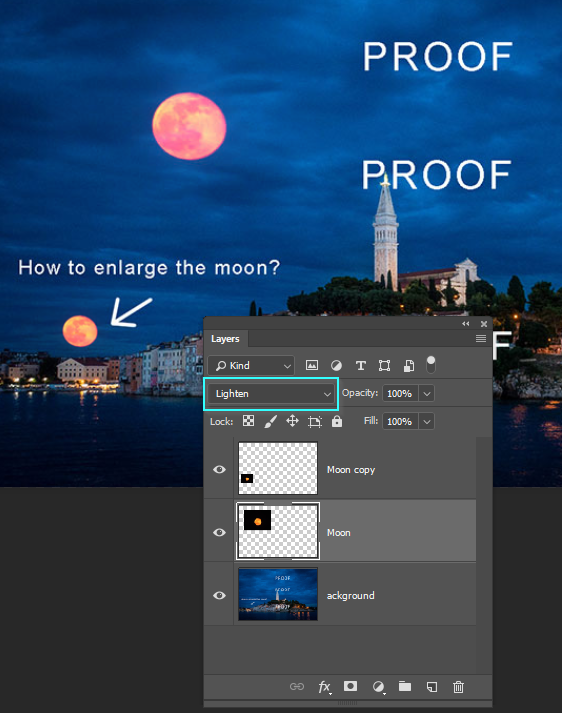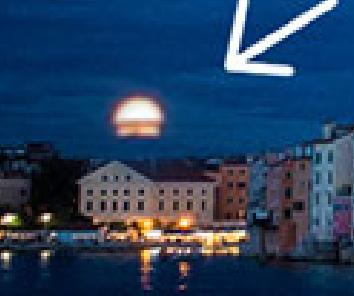- Home
- Photoshop ecosystem
- Discussions
- How to make the moon a little bigger?
- How to make the moon a little bigger?
How to make the moon a little bigger?
Copy link to clipboard
Copied
Hi,
I am struggling with something that I know is fairly easy: how to make the moon a little bigger. See image below. I'd like to enlarge the moon by 25-50%.
I've tried making a selection with the rectangular or elliptical marquee tool. Then using either transform>scale, or free transform, or content-aware transform, when I make the selection larger, I see the edge of the selection. I've tried feathering the selection, but that's not working--I still see the selection after it is enlarged. Should I be duplicating the background layer perhaps?
Thanks for any help with this!
John
EDIT: I tried duplicating the background layer and using free transform with the selection feathered. That works pretty well, but perhaps there is an even better technique. Thanks!

Explore related tutorials & articles
Copy link to clipboard
Copied
Duplicating the background layer is a good idea, to protect it while you experiment.
What I'd suggest is to make a fairly accurate selection of the moon. Doesn't have to be absolutely perfect.

Copy and past it onto a new layer.
Enlarge it with Edit > Transform.

Then change the layer blending mode to Lighten.

Copy link to clipboard
Copied
Because upressing is usually not a good idea because of pixelation, if it was my picture, I'd photograph the moon again, and composite.
you can see in this example, that I did not try and select the moon, but set the layer blend mode to Lighten which made the black become transparent (because it is darker than the image pixels behind it).

If you want to use Free Transform and avoid the hard edge, make the selection a little loose, and use Feather Selection (F5) to blur the outer pixels

Copy the selection to a new layer, and use FT to make it bigger. There is no had edge here.

Note: I did try this without copying to a new layer, but it resulted in this brighter fringe. I might have blurred the selection a touch too much, but otherwise, I am not sure why that happened. davescm anyone?

[EDIT] OK I have found out that caused the bright collar. There was a 3 pixel feather set in the Options bar. I hate trying to use this laptop for Photoshop as I can see WTH is going on 😞

Copy link to clipboard
Copied
As Dennis said, upsampling is not a good idea. But you might be able to get away with it in this case because the moon doesn't have much detail and if you don't increase the moon size more than 120%, and possibly give it just a small amount of gaussian blur.
Copy link to clipboard
Copied
Personally, I would have searched in Adobe Assets, or public domain stock photos and placed a moon there. Simply because, depending on the quality of the photo, when you stretch it it gets really pixelated, and sometimes you can fix it, and many times we can't.
Copy link to clipboard
Copied
Hi
As others have said, I would replace the moon.
Use the spot healing brush to remove the old moon.
Set the new moon to screen
Adjust the color with a curve/Hue &Sat layer
Add in the clouds over the moon face
Don't forget to reflect the larger moon in the water surface

Dave
Copy link to clipboard
Copied
I like your attention to detail Dave, brushing the clouds back over the new moon.
Copy link to clipboard
Copied
Cheers Trevor. I think the more compositing we do, the more we see little things that jar the eye. A moon in front of the clouds would have done that to me ![]() Mind you, we have all finished something, posted (or printed it) then spotted the glaring one!
Mind you, we have all finished something, posted (or printed it) then spotted the glaring one!
Dave
Copy link to clipboard
Copied
Good call. Any little thing to hide that it was photomanipulated, the better
Copy link to clipboard
Copied
davescm wrote
Cheers Trevor. I think the more compositing we do, the more we see little things that jar the eye. A moon in front of the clouds would have done that to me Mind you, we have all finished something, posted (or printed it) then spotted the glaring one!
Dave
I love the BBC News 'Week in Pictures' section. It is photojournalism at its best. The images are often inspirational, and this image of an attacking helicopter gunship is sensationally good, but also instructive. I love the raged nature of the flames, both in front, and behind what I assume are the rocket launchers. It would be too easy to use a symmetrical flame if compositing or illustrating this. I also like pattern of the smoke which partially covers the flame. I'd be hesitant to put the rockets in the frame because it would be too much of a stretch, but here they are in an undoctored news picture, and the trails are amazing as well. I sat and looked at this picture for ages yesterday, and saved it to a local drive so I can use it as a reference in the future. I think that we don't spend enough time looking at real life pictures, and that can lead to mistakes when compositing or illustrating. Some of the SFTW pictures cry out for critical feedback, but I don't feel comfortable offering it unless it is asked for.

Copy link to clipboard
Copied
davescm wrote
Don't forget to reflect the larger moon in the water surface
Er...I'm not sure there would be a reflection at all, at this low angle. It's hidden "above" the rooftops. There's no reflection now, so why would there be with a larger one?
Other than that - my opinion: Please don't ruin a perfectly splendid image! Would it improve the shot if the moon was slightly bigger? No, it wouldn't.
Copy link to clipboard
Copied
https://forums.adobe.com/people/D+Fosse wrote
davescm wrote
Don't forget to reflect the larger moon in the water surface
. There's no reflection now, so why would there be with a larger one?
I also moved it up - but I take you're point ![]()
Dave
Copy link to clipboard
Copied
As the one who asked this question in the first place, I can't thank you all enough for taking the time to post your "how-to" suggestions, tips and comments. The PS and LR forums have always been invaluable to me, and this discussion is no exception.
D Fosse, I appreciate your comment about the image. My reason for considering enlarging the moon is that doing so would make the moon look a little more like what it looked like to the naked eye. This was shot with a 24mm (equivalent) lens, and that of course makes the moon smaller than it appeared. A "slight tweak," maybe no more than 25% or so would add a bit of drama to the moon without it looking over manipulated or phony. I will give it a try--now that I know how--and then decide on how the final print should look.
Thanks again to all of you!
John
Find more inspiration, events, and resources on the new Adobe Community
Explore Now
